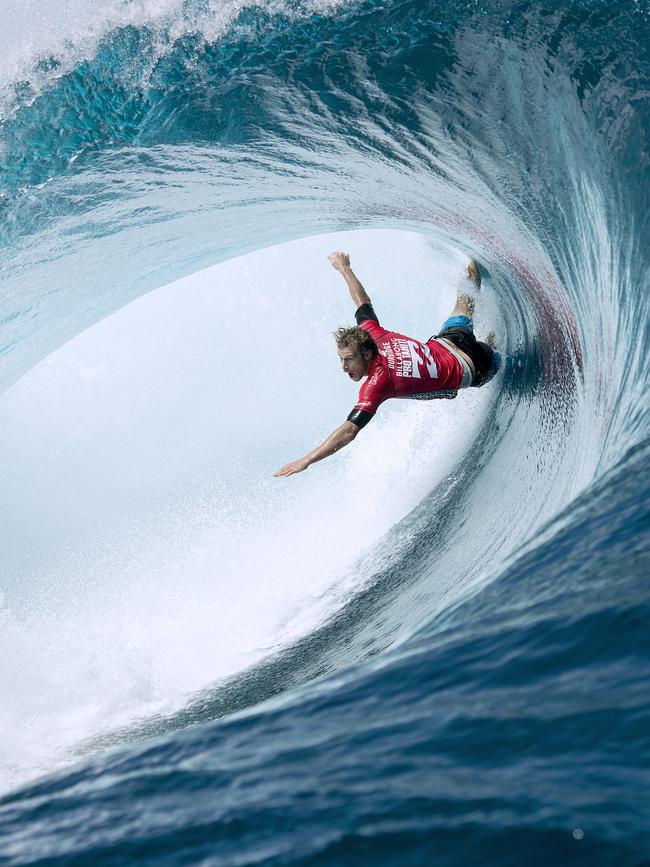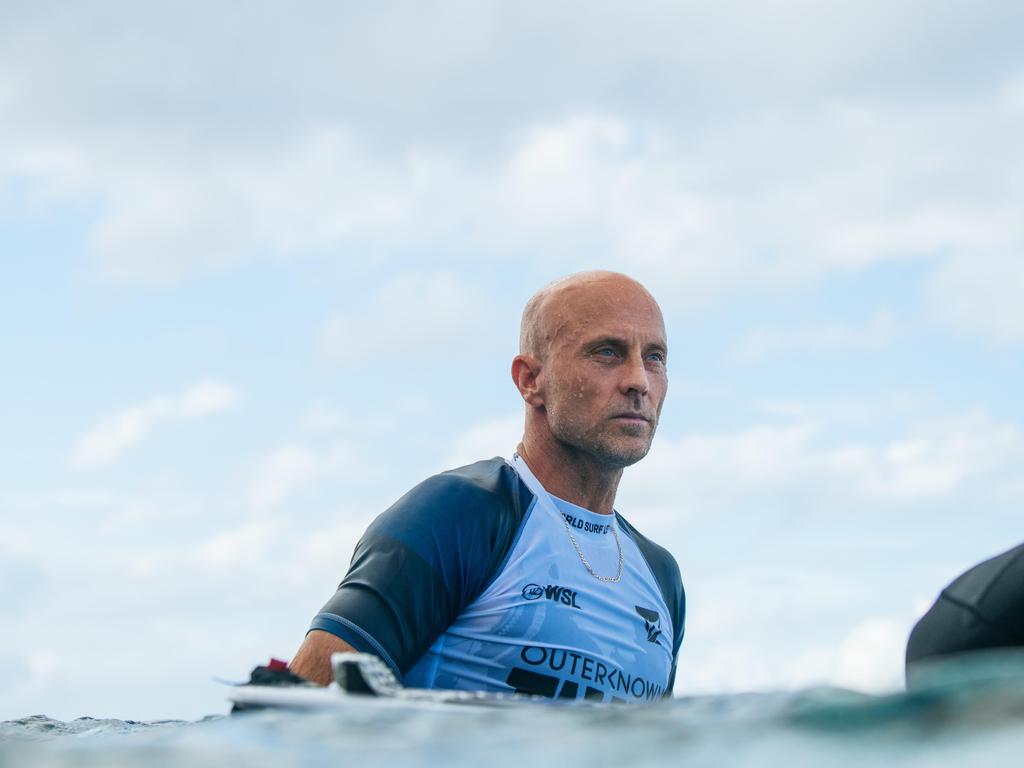More than 15,000km away from Paris a select few Olympians will be paddling into waves off Tahiti that have taken lives. Our interactive guide takes you inside Teahupo’o, as do the Australian surfing legends who have crossed its path.
“Someone could die in the Olympics”.
That’s the blunt analysis of Australian and former world tour surfer Bede Durbidge as he prepares to watch his compatriots compete for gold at the Tahitian surf break of Teahupo’o.
While athletes from around the world descend on the streets of Paris for the 2024 Olympics, more than 15,000km away a select few will be paddling into waves off the French Polynesian island that has taken lives.
“It’s the best entertainment you will ever see,” Durbidge continued about a break labelled a ‘wave of consequence’ for obvious reasons.
“The energy from the wave is psycho, it’s electrifying.”

Durbidge spent years competing at Teahupo’o while on the World Surf League’s Championship Tour but Nathan Hedge is the Australian who boasts the most experience at the famous left-hand break.
Hedge, 45, has spent a total of 25 years mastering one of the heaviest waves on the globe and said surfing the monster barrels – sometimes standing more than seven feet tall – put you inches from death.
“You actually feel like you are fighting for your life,” Hedge said.

“At the end of most other sporting events you are pretty sure you are going to be alive.
“You are not going to get limbs ripped off or cut and you are not going to be rescued.
“I dislocated my shoulder out there. I have had teeth pulled through my bottom lip, I have had gashes on my head. There have been some horrific injuries at Tahiti.
“I have been waiting for the next heat and watched guys get absolutely annihilated, put on the rescue sled and sent off to the hospital and they have put the event on hold.
“Then you have to paddle back out there and re-enter the coliseum again straight after.
“There have been people who have passed away out there or had horrific injuries.
“The trade off is that you could get the best wave of your life or you could get the worse beating of your life. You weigh it up.”
Come July 27 Australian quartet Jack Robinson, Ethan Ewing, Tyler Wright and Molly Picklum will begin their quest to tame the sea and bring gold back Down Under.
The risk of injury is widespread but there is concern surrounding non-world tour surfers who are either yet to surf the break or have done so minimal times.
The Australians are all on the world tour where the men have been surfing Teahupo’o for years while the women have had added exposure to it since it returned to their calendars in 2022.
But a field including 14-year-old Chinese surfer Siqi Yang and other relative novices could find themselves in perilous conditions and how they handle one of the world’s most dangerous waves is yet to be seen.
“It’s an interesting one. I don’t really know those surfers, so I’m sure they’re nervous,” Picklum said about Tahiti’s newcomers.
“I’m sure the (Olympic) committee’s going to be really picky with what (conditoins) we’re put in.
“Honestly even fun-sized Teahupo’o, which they will run the event in, will still be scary and dangerous for them.
“At the end of the day if they’re super scared and feel unsafe then they don’t have to paddle into the lineup.”
MECHANICS OF THE MONSTER
Teahupo’o is the ultimate contrast. The island’s untouched greenery and climbing hills combined with the clarity of the water and the reef below its surface have made it one of the most popular holiday destinations for tourists from around the world.
The wave is the chaos among the calm.
As Hedge puts it, you can drive a bus through the barrels they are so hollow.
The lip of the wave is so heavy that its pressure is like a dam wall bursting, it’s like riding a bucking bronco inside the tube and it’s like a fire hydrant going off when the wave decides to spit you out the other end.
The most impressive swells that create the force for the wave in the South Pacific Ocean are generated off the coasts of Australia and New Zealand.
The water is pushed from the southwest until it reaches Tahiti where water goes from hundreds of feet deep to 10.
All the power that has gone unimpeded for so long meets resistance for the first time and forces the wave to break onto the shallow reef with enormous energy.
By the time the surfer gets on the wave it is often six-feet deep until the sharp reef at the bottom and by the time the athlete reaches the end of the tube it is often a foot deep or breaking on to dry reef.
“There is nothing you can do (if you come off on to dry reef),” Hedge said.
“You have to hope there is a wave in front that washes you into the lagoon that is about 20 feet away.
“Because the wave energy goes down the reef the water tries to escape and like a rapid it goes back out into the ocean to tries to dispel the wave’s energy.
“Some of it goes into the lagoon but a lot of the wave energy will return back out to the sea. “If you get stuck in that rip there is a right-hand that breaks on top of your head on dry reef.”
Hedge knows just how it feels to be caught in the red zone.
“I have been on a jetski that flipped back over on to the reef,” Hedge said, detailing how he thought he was about to die.
“We tried to punch through a wave and got sucked up over the falls.”
THE TAKE OFF
One of the greatest challenges Teahupo’o presents is the three to five second window that it gives surfers to make a potentially life-altering decision.
“Generally as a surfer you will get some notice of an outer reef or you will get an indicator style wave,” Hedge said
“You will have some inkling that you have a bigger set wave approaching. When you surf Teahupo’o, because the ledge drops off the back of the shelf into a couple of hundred feet of water you don’t get the warning because the wave hasn’t stood up.
“As soon as it gets to the shallow reef it stands up. You don’t get the luxury of time. It is upon you very quick.
“You have to make an instantaneous decision of where am I in the line up? Do I want this? “Then you turn and to paddle. You probably get three to five seconds to look at the wave and decide if you want to get it.”
The race against time isn’t the only unique aspect of the wave.
“Because there is so much water drawing from the lagoon back out it is very difficult to get down the wave,” Hedge said.
“You need to be almost underneath and inside the ledge paddling down.
“You have to stay under the lip-line when your hands leave the rail of the board.
“When you jump up and stand up you need to be inside the wave.”
Choosing the right wave to surf becomes a mental battle. Hedge said athletes need to do what their mind believes is impossible.
“The style of wave that it is, you can’t go over the top or pull through the wave,” Hedge said.
“There is no get out of jail free card. You see the wave and your mind is telling you that it will close-out and not makeable but they are the ones that give you high-point rides that will win you a medal.”
INSIDE THE WAVE AND COMPLETE EUPHORIA
Hedge has recorded two 10 point rides at Teahupo’o and beaten surfers ranked one and two in the world respectively in 2022, including Robinson.
His knowledge of what it takes to navigate through the tube is world class but even the best come undone from the pressure behind the curtain of water.
“When the lip comes over the reverberation from the water coming back up the face of the wave is the foam ball and it’s like an explosion,” Hedge said.
“When you go deep you are riding on the foam ball and the turbulence, it’s like a bucking bronco inside on the board.
“So you have to hold your line. It gets super technical when you are inside. Some of the water from the foam ball still needs to go outside the end of the wave and that is when you see the wave spit and blow out.
“It is like a fire hydrant going off. You can get blown off your board because it is seriously like going to a blow hole.
“When it spits hard you can’t see anything.”
Hedge said conquering the wave brings with it a level of euphoria unlike anything else.
“You are so stoked you made the wave because if it is going to be a 10 and that intense it is going to take you to a place that is so uncomfortable that when you get to the other side of that it is pure elation,” Hedge said.
“It is a feeling that is surviving an avalanche or the Everest summit peak moment.
“It’s a pivotal moment in your life. Your whole body is tingling and as a surfer getting those rides is the ultimate when it all comes together.”
That’s the feeling the Aussies are chasing and one that will secure the nation’s first gold medal in surfing.
*****
Why is Teahupo’o known as the heaviest wave in the world?
The lip of the wave is so heavy that its pressure is like a dam wall bursting, it’s like riding a bucking bronco inside the tube and it’s like a fire hydrant going off when the wave decides to spit you out the other end.
Has anyone died on the Teahupo’o wave?
Reportedly, there has been five deaths on the Teahupo’o wave.
How deep is the Teahupo’o Reef?
The most impressive swells that create the force for the wave in the South Pacific Ocean are generated off the coasts of Australia and New Zealand.
The water is pushed from the southwest until it reaches Tahiti where water goes from hundreds of feet deep to 10 (from three metres to 30 plus metres).
Weather forecast
The competition is likely to open with good conditions and an offshore wind, with larger surf developing for the medal rounds.

Add your comment to this story
To join the conversation, please log in. Don't have an account? Register
Join the conversation, you are commenting as Logout
Clearest sign yet Swimming Australia’s ‘boys club’ is ending
There is just one female coach on the swim team for next month’s world titles, but the gender imbalance is slowly changing despite Swimming Australia killing off a quota proposal for women.
‘We’re going to deliver’: Premier vows Olympic rowing will be held in Rocky
Premier David Crisafulli has vowed to keep his promise to host Olympic and Paralympic rowing in Rockhampton, despite the outcome of a global assessment on the Fitzroy River.